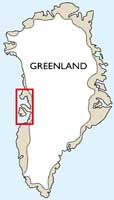 |
West
Greenland was hot – how else can you
make 22,000 km3 of picrites? |
Lotte Melchior
Larsen1 & Asger
Ken Pedersen2
1Geological Survey of Denmark and Greenland
(GEUS), Øster
Voldgade 10, DK-1350 Copenhagen K, Denmark,
lml@geus.dk
2Natural History Museum of Denmark, Øster
Voldgade 5-7, DK-1350 Copenhagen
K, Denmark, akp@snm.ku.dk
 Click here to
download a PDF version of this webpage Click here to
download a PDF version of this webpage
Introduction
The controversy regarding the temperatures of formation
of the Paleocene volcanic succession in West Greenland
and Baffin Island has just celebrated its 50 years’ anniversary
(Drever & Johnston, 1957; Clarke,
1970; Hart & Davis, 1978; Clarke & O’Hara,
1979; Elthon & Ridley, 1979; Francis,
1985; Larsen & Pedersen, 2000). Most recently, Natland (2008)
has called the high temperatures calculated for West
Greenland into doubt and also presented an alternative
model for the formation of the picrites.
Our contribution
consists of two parts. First, we attempt to clarify
some features of the West Greenland volcanic succession
that have not generally been appreciated or have been
misinterpreted. Second, we comment directly on some
aspects of Natland’s paper.
Facts about West Greenland
Extent and volume
The Paleocene volcanic succession
in West Greenland extends from south of Disko to north
of Svartenhuk Halvø (Figure 1). It consists
of two parts, a lower part consisting dominantly of
picrites, and an upper part consisting of basalts (Clarke & Pedersen,
1976). The picrites have been formalised as the Vaigat
Formation whereas the basalt succession has been
named variously in different parts of the region.
The volcanic areas can be inscribed within an ellipse
with a long (N–S) diameter of 430 km and a
short (W–E) diameter of 200 km, giving
a total area of 68,000 km2. There are enough lavas
known in the offshore areas and as erosion remnants
in the eastern basement areas to be sure that most
of this area was once covered with volcanic rocks.
The picrites are less extensive than the basalts
and occur from central Disko to Svartenhuk Halvø.
The areas with picrites can be inscribed within a
smaller ellipse with a long (N–S) diameter
of 250 km and a short (W–E) diameter of 110
km, giving a total area of 22,000 km2.
The two ellipses are remarkably concentric (Figure
1).
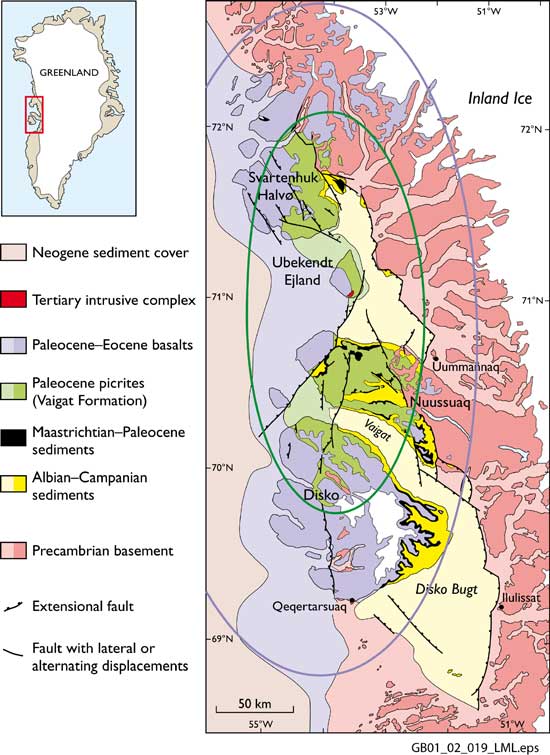
Figure 1. The West Greenland Tertiary
volcanic province. The purple ellipse circumscribes
the basalt areas and the green ellipse circumscribes
the picrite areas (the Vaigat Formation).
Thicknesses
given in the following are our data for Disko and
Nuussuaq, from Drever (1958) and Larsen (1977)
for Ubekendt Ejland, and from Larsen & Pulvertaft (2000) for Svartenhuk
Halvø. The thickness of the basalt succession varies from maxima
of 2,000 m on Disko, 3,000–4,000 m on Ubekendt Ejland, and 2,000 m on
Svartenhuk Halvø to considerably less (a few hundred metres) in the
eroded areas where only remnants are left. We consider an average thickness
of 1,000 m a workable figure for the basalts. The thickness of the picrite
succession (the Vaigat Formation) increases from the peripheral areas
to the central areas of the ellipse in Figure 1. It is about 900 m in central
Disko, eastern Nuussuaq and northern Svartenhuk Halvø, 1,000–1,500
m in northern Disko, central Nuussuaq and central Svartenhuk Halvø,
1,500 m in western Nuussuaq (erosion-corrected to 2,500 m), 4–4.5 km
in southern Svartenhuk Halvø, and more than 5 km on Ubekendt Ejland.
On Ubekendt Ejland, moreover, the lower part of the Vaigat Formation is below
sea level. An average thickness is thus uncertain, but we consider that 1,000
m for the whole picrite ellipse in Figure 1 is a very conservative estimate.
These thicknesses lead to estimated volumes of 22,000 km3 of erupted
picrites and 68,000 km3 of erupted basalt. West Greenland is thus
not a very large LIP (Large Igneous Province), but about one third of the erupted
volume consists of picrites. This does not even take into account that picrites
contemporaneous with those in West Greenland were also erupted in the Cape
Dyer area on Baffin Island. Similar volumes of picrite are to our knowledge
only reported from the Karoo LIP (the Letaba Formation of Bristow, 1984). This situation
is quite different from other flood basalt successions such as Deccan or Gorgona
where picrites occur but only form a very subordinate part of the erupted lavas.
Lithologies in the Vaigat Formation
During the emplacement of the Vaigat Formation some
magma batches stalled in high-level magma chambers
in the 6–8 km thick sedimentary packet and became
contaminated. The contaminated volcanic rocks form
some well-defined separate units consisting mainly
of siliceous magnesian basalts, Mg-poor picrites and
magnesian basaltic andesites but also magnesian andesites,
sometimes with graphite or native iron formed by reduction
processes due to reaction with organic-rich sediments.
Their chemical and isotopic compositions make them
easily distinguishable from uncontaminated rocks. Such
contaminated rocks constitute 4–5% of the total
volume of the Vaigat Formation in the Disko-Nuussuaq
area and about the same amount in Svartenhuk Halvø;
on Ubekendt Ejland such rocks are either absent or
very inconspicuous in the exposed part of the formation.
All rocks in the Vaigat Formation that are more evolved
than basalt have acquired their composition by contamination
processes and not by normal crystal fractionation.
The
remaining 95% or more of the Vaigat Formation consist
of uncontaminated picrites and basalts. After detailed
mapping in Disko and Nuussuaq we now have a complete
stratigraphy for that area and coverage of all stratigraphic
units with samples and chemical analyses. We can therefore
make quantitative statements about the constitution
of the Vaigat Formation in that area. Ubekendt Ejland and Svartenhuk Halvø have
been mapped earlier (by other teams), and the analytical coverage there is
sufficient for general statements but not for the same degree of quantification
as on Disko and Nuussuaq.
Uncontaminated rock compositions
vary along olivine control lines with large variations
in MgO. In Disko and Nuussuaq the total variation is
6.5–30.8 wt% MgO. The rocks (lava flows
and pillow breccias) were sampled in profiles and samples were intended to
be representative (olivine-rich accumulation zones in lava flows were generally
avoided). We found that the amount of basalt (MgO<12 wt%) is subordinate,
and the amount of basalt with MgO<8 wt% is very small and confined to a
few minor units near the bottom, middle and top of the formation. The calculated
volume-weighted average for our analyses of the uncontaminated Vaigat Formation
is 16.6 wt% MgO (482 samples). Ubekendt Ejland and Svartenhuk Halvø are
also dominated by picritic lithologies and the averages there cannot be much
different from that for Disko and Nuussuaq. The Vaigat Formation is thus truly
picritic.
Petrography of the picrites
Picrite lavas
have phenocrysts of olivine with chromite inclusions
and groundmasses of olivine, plagioclase, clinopyroxene,
and Fe-Ti oxides. Many picrite lava flows were erupted
subaerially and subsequently flowed into the sea or
a large lake where they were quenched to pillow breccias.
The pillows have well preserved glass rinds, and therefore
the mineral assemblage at the stage of quenching is
very well known. The pillow rinds consist of fresh
yellow glass and up to about one third olivine crystals
with chromite inclusions; small euhedral chromites
also occur in the glass. The olivines range from equant
euhedral crystals to very elongate hopper morphologies
which in some cases constitute a significant proportion
of the olivine. In some cases tiny plagioclase microlites
formed in the melt immediately prior to quenching
to glass. Picrites and magnesian basalts with more
than 8 wt% MgO do not have either plagioclase or
clinopyroxene phenocrysts or microphenocrysts in
the glass. The rare plagioclase-phyric basalts do
have plagioclase phenocrysts and a few clinopyroxene
microphenocrysts in the pillow glasses. We have not
observed kink-banded olivines except for rare crystals
that are deformed and cracked during flowage of the
lava. More descriptions and photographs are given
in Larsen & Pedersen (2000).
The olivines
range in composition from Mg# 77.4 to 93.3 (Fo% 76.6–92.4).
The crystals are normally zoned, also the elongate,
skeletal hopper crystals, and the crystal rims are
in equilibrium with the surrounding glass. The major
part of the olivine population has compositions in
the interval Fo 84–90 and only a small part
of the crystals have Fo 90–92.5; however such
Mg-rich compositions are found in most of the microprobed
picrite samples. The olivine crystals contain glass inclusions and have high
contents of Ca (0.25–0.45 wt% CaO) and Cr (0.03–0.18 wt% Cr2O3),
indicating beyond doubt that they crystallised from a melt; they are not metamorphic
olivines.
Mineral evidence for high temperatures
Chromium in olivine
A plot of Cr2O3 vs. Fo
in olivine is shown in Figure 2. It is very rare to
find such high chromium contents in olivine; according
to Li et al. (1995)
the vast majority of olivines from magnesian basaltic
magmas contain < 0.02 wt% Cr2O3.
These authors stated that high Cr2O3 (>0.1
wt% Cr2O3)
in terrestrial olivines is only found in komatiites,
olivine inclusions in diamonds, some very high temperature
peridotite xenoliths, and olivine in some ultramafic
pseudotachylites (Li et al., 1995, p. 126).
They concluded that “temperature plays an enormously
important part in the stability of Cr2+ in olivine
at terrestrial oxygen fugacity conditions.” Li
et al. (1995)
constructed a diagram of isopleths of Cr in olivine vs. temperature
which is shown here as Figure 3. The magmas of the
Vaigat Formation were not particularly reduced (Larsen & Pedersen,
2000) and at high temperatures were close to the FMQ
buffer. The high-Mg olivines (with Fo % >90) have
Cr2O3=0.10–0.18 wt%, corresponding
to XCr-in-olivine=0.001–0.0018,
and therefore crystallised at temperatures of more
than 1740°K, i.e., 1467°C. This temperature is in accordance
with our backtrack calculations (Larsen & Pedersen, 2000).
The olivines with Fo %<90 have lower chromium contents
(0.10–0.04 wt% Cr2O3) in
compositional continuity with the high-Mg olivines;
they crystallised at successively lower temperatures
down to quenching at 1160–1218°C.
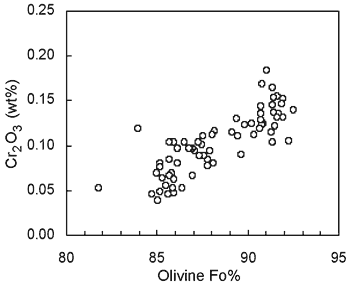
Figure 2. Chromium contents in
the olivines from the Vaigat Formation, West Greenland.
Data in Larsen & Pedersen (2000), supplementary
data.
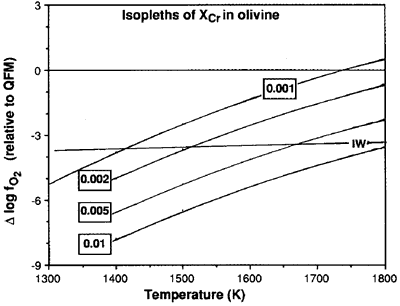
Figure 3. Isopleths of XCr-in-olivine in equilibrium
with spinel at zero pressure. The pressure dependence
is very small. From Li et al. (1995), reproduced
with permission from Oxford University Press.
Spinel compositions
Like the olivines, the
spinels crystallised over a range of temperatures,
and the high-temperature signal resides in the spinels
included in the high-Mg olivines. It is clear from
Figure 4 that the spinels in the high-Mg olivines have
very high Mg# and high Cr#; they have also low Fe#
and Ti contents (see Larsen & Pedersen,
2000). These spinels are similar to spinels from
the Kambalda komatiites produced experimentally at
1350-1500°C (Murck & Campbell, 1986).
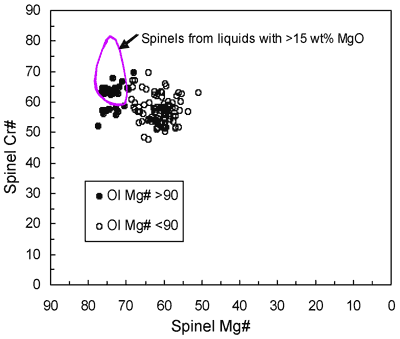
Figure 4. Spinel compositions in
the Vaigat Formation, grouped according to Mg# of
the enclosing olivine. Xenocrysts are not plotted.
Data from Larsen & Pedersen (2000), supplementary
data. The purple field of spinels from liquids with >15
wt% MgO is from Natland (2008, Figure 4).
Discussion of the paper by J. H. Natland:
Eruptive temperatures of the Paleogene picrites of
West Greenland and Baffin Bay
In the following,
quotations from Natland (2008) are shown in italics
and within quotation marks. Our comments are written
in normal font.
“Petrological backdrop”
“The stratigraphy also includes silicic
lava or tuff (mainly dacite and rhyolite)”.
Comment:
As explained above, the most evolved uncontaminated
rocks in the Vaigat Formation are basalt with 6.5 wt%
MgO. Dacites and rhyolites do not occur. Such rocks
do constitute a subordinate part of the uppermost members
of the overlying basalts (the Maligât Formation),
and they are all strongly crustally contaminated. It
is also true of the Maligât Formation that the
most evolved uncontaminated rocks are basalts.
“Another surprise……is that ……the
picrites have low delta-Nb ….”
Comment:
The West Greenland and Baffin Island picrites and
basalts are more depleted in the most incompatible
elements than Iceland. They are not so depleted in
the less-incompatible elements such as Ti. We are not
surprised at all because why should these rocks be
identical to those formed today in Iceland? The differences
are inherent in the mantle in which the melts originated;
they have nothing to do with assimilation of rhyolite
because the rocks are not crustally contaminated; contamination
would immediately show up in the isotopic compositions.
“Is very forsteritic olivine ….a
relic of an ancient melting event?”
Comment:
The very forsteritic olivines (Fo 90–92.5)
crystallised from a melt, as proved by their high contents
of Cr, Ca, and glass inclusions (see above). An olivine
cumulate from an ancient melt, resident under mantle
pressures and temperatures since the Archaean, would
not have been able to retain the Cr in the crystal
structure but would have exsolved it as chromite dust.
Olivine from cumulates in the continental lithosphere
can only be part of the Paleocene picrites if the crystals
were melted completely, and this would have required
an extraordinary amount of heat. We fail to see the
necessity of invoking an ancient high-temperature melting
event when a Paleocene one can explain all the data.
“Glasses are cotectic liquid compositions
with olivine xenocrysts”
“ …none of it [the analyzed glass]
is olivine-controlled. …. Glass compositions
fall along a low-pressure plagioclase-olivine clinopyroxene
cotectic…..”
Comment on the West
Greenland glasses: Larsen & Pedersen (2000)
published analyses of both glass inclusions in olivine
and matrix glasses. The glass inclusions are re-equilibrated
with the surrounding olivine, and we did not use them
for any petrological calculations. On the other hand,
the quenched glasses in the pillow rinds (matrix glasses)
are abundant and very fresh. The matrix glass in any
one sample is quite homogeneous, and in total the glasses
have a restricted compositional range, with 6.7–8.8
wt% MgO, 13.5–15.1 w% Al2O3,
and 12.1–14.6
wt% CaO, i.e., they have a relatively large plagioclase
component (Figure 5). The largest relative range is
seen in TiO2 which ranges from 1.35 to 1.93 wt%; this
variation is caused by differences in the primary magmas
produced over time which is corroborated by differences
in the isotopic compositions of the bulk rocks (yet
unpublished data, but see Holm et al., 1993).
The glass compositions in Figure 5 show no indication
of fractionation of either plagioclase or clinopyroxene.
It appears both petrographically (see above under petrography
of the picrites) and chemically that the melts simply
quenched on approach to the two- or three-phase cotectic
phase boundary.
In summary: Yes, the matrix
glasses are cotectic or near-cotectic liquids. But
they are olivine-controlled because the various packets
of magma arrived at the cotectic surface by fractionation
of olivine from parental liquids that had different
contents of TiO2 (and FeO). Thus, the individual fractionation
paths in Larsen & Pedersen (2000,
Figure 11), also depicted in Natland (2008,
Figure 2C) form individual, near-parallel lines. What
is seen as ‘cotectic trends’ of the glasses
in the compositional diagrams are the traces of the cotectic surface in the
plots (O’Hara, 1968).
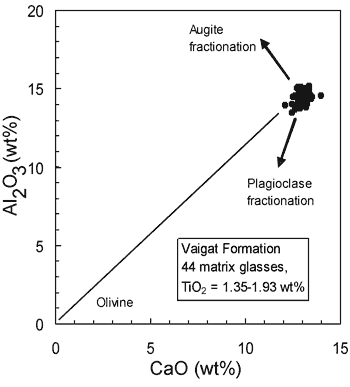
Figure 5. Composition of glass in pillow rinds.
Data in Larsen & Pedersen (2000), supplementary
data.
“Following the rationale developed for Samoa…..”
Comment:
This rationale is based on plots of matrix glass compositions
in a diagram of Al2O3 vs. CaO.
The Samoa lavas have phenocrysts of clinopyroxene
and some of the Samoa glasses duly show depletion
in CaO and enrichment in Al2O3 caused
by fractionation of clinopyroxene (Natland, 2008b, Figure
2). Following the rationale developed for Samoa,
the very tight cluster of the West Greenland matrix
glasses in Figure 5 indicates no fractionation of
either plagioclase or clinopyroxene. Thus again,
there is no evidence whatsoever, either petrographical
or chemical, for fractionation of other phases than
olivine and spinel from the matrix glasses. They
can safely be used for backtrack calculations of
melt compositions by adding olivine back into the
glass.
“Melt inclusions”
Comment:
The melt inclusions we analysed are clearly out of
equilibrium with the surrounding olivine after deposition
of olivine on the inclusion walls and re-equilibration
of olivine and glass, including loss of both MgO and
FeO from the glass to the olivine (Larsen & Pedersen,
2000; see also Gaetani & Watson,
2000). We agree with Natland that the melt inclusions
are difficult or impossible to reconstitute and should
not be used for backtrack calculations. We have also
not done so; we presented the melt inclusions as
analysed and used the well-defined matrix glasses
from the pillow rinds for backtrack calculations.
“The crystallization and mixing histories…..”
Comment:
As we envisaged the picrites in our 2000 paper, the
primitive melts were not erupted. The melts precipitated
olivine continuously in the conduit systems on their
way to the surface and lost heat in the process.
The conduit systems were lined with olivine crystals
left by previous melt batches, and the passing melts
picked some of these olivines up while they left
others behind. The erupted magmas were slurries
of olivine in melts that contained no more than 14
wt% MgO, often less. This concept of slurries is
not very different from that of Natland (2008).
The difference lies in that we consider all the olivine
to be cognate (note the compositional continuity
of the total olivine trend in Figure 2), and that
high-Mg, high-temperature melts did exist at depth
but were just not erupted. The high-Mg olivines and
spinels bear all the hallmarks of having formed at
very high temperatures, and we consider them to provide
evidence of the least evolved asthenospheric melts.
Natland (2008)
suggests a very different model of picrite formation
in which the picrites are mixtures of evolved, cotectic
magmas and xenocrystic olivines. He envisages magma
chambers in which low-pressure fractionation of olivine,
plagioclase and clinopyroxene took place, after which
the basaltic melts left their phenocrysts completely
behind, moved upwards and into areas with “stagnant masses of some
other magma at depth”, picked up olivine crystals from these stagnant
magmas, and from the wall rocks, in amounts up to one third or more of the
total volume, and proceeded to erupt on the surface. This model seems extraordinarily
complicated. Which magma was sitting around at higher levels than the low-pressure
magma chambers? It must have been very magnesian and very voluminous in order
to provide enough olivine to make the picrites. A corollary of Natland’s
theory is that the cotectic basalt magmas with around
8 wt% MgO must on average have picked up 22 wt% (around
30 vol%) olivine (Fo 88) in order for the Vaigat Formation
to get an average composition of 16.6 wt% MgO. More
than one fourth of the total erupted volume of 22,000
km3 of picrites must therefore be ascribed
to “some other magma” and wall rocks. This is contrived.
“Further difficulties with reconstructed
melt inclusions”
Comment: We
basically agree on the difficulties. However, Natland
compares melt inclusions from Greenland and Iceland,
and melt inclusions in plagioclase and clinopyroxene
are brought into the argument. We therefore reiterate:
There are no phenocrysts of plagioclase or clinopyroxene
in the picrites in West Greenland. We are well aware
that the Icelandic picrites contain plagioclase phenocrysts,
and that only stresses the difference between the two;
but plagioclase in Icelandic picrites does not imply
or necessitate plagioclase in Greenlandic picrites.
“Olivine in picrite might thus have many
origins, including some crystals that might be from
ancient dunite cumulates…..”
Comment:
If this is the case in West Greenland, the different
populations of olivine picked up must have re-equilibrated
heavily in order to no longer form discrete compositional
populations. Moreover, the re-equilibration must
have stopped just at the moment a continuous compositional
suite was formed that looks exactly like one formed
by continuous crystallisation of olivine from closely
related parental magmas (Figure 2 and Larsen & Pedersen,
2000). This is no small requirement as olivines re-equilibrate very easily
and complete re-equilibration would be achieved in a few months’ time
(Jurewich & Watson, 1988). Completely re-equilibrated rocks do
occur occasionally (Larsen & Pedersen (2000) sample 264217), but
they are an exception.
The picrites in West Greenland
and Baffin Island have very tightly constrained, chondritic
to suprachondritic osmium isotopic compositions (187Os/188Osinitial
= 0.1268–0.1322, Dale
et al., 2009) which would not be expected if
the rocks contained varying amounts of different
populations of olivine of various origins. In contrast,
the dunites of Ubekendt Ejland have scattered, mainly
distinctly subchondritic osmium isotopic compositions
(Bernstein et al., 2006) which effectively
rules them out as a significant component in the picrites.
Thus, the very high 3He/4He
in the picrites (up to 50 Ra, Graham et al.,
1998; Starkey
et al., 2009) cannot originate in dunitic cumulates
as suggested by Natland (2008).
Again, we
reiterate: the high-Mg olivines could not have survived
millions of years at mantle temperatures without
exsolving their high chromium contents into chromite.
Why postulate an ancient high-temperature melting
event in preference to a Paleocene event?
The ancient
dunite cumulates may be a way of diminishing the problem
with the “some other magma” invoked
earlier. However, the problem of accounting for more
than one fourth of the total erupted volume of picrites
is not removed.
“could it really be a coincidence that such
magnesian olivine just happens to occur in the lithosphere
where “plume head” picrite erupts?”
Such
magnesian olivine, and dunite, occurs in the lithosphere
beneath the whole Precambrian craton of Greenland and
is brought to the surface as xenoliths whenever alkaline
mafic and ultramafic rocks erupt or intrude (South
Greenland: Emeleus & Andrews, 1975; Southern
West Greenland: Bizzarro & Stevenson,
2003; general: Wittig et al., 2008). The olivine
in these dunites has low Cr contents, <0.05 wt%
Cr2O3, including the dunitic
olivine from Ubekendt Ejland (Bernstein et al.,
2006).
“Spinel”
Figure 3: ”Most of this field [spinels
from melts with MgO>15%] does not overlap natural
spinel from West Greenland and Padloping Island…”
Comment:
About seven spinel analyses from West Greenland indeed
plot close to or in the “>15% MgO-in-melt” data
field (purple) in Figure 3 of Natland (2008).
These would be the high-Mg spinels in Table 2 of Larsen & Pedersen (2000).
The full data set is shown here in Figure 4 above,
and if these analyses are plotted too, several spinels
with Cr#=62–68 and Mg#=70–77, all from
olivines with Fo>90, plot in the field of melts
with >15% MgO. The spinels in olivine with Fo<90
were formed from melts with lower MgO at lower temperatures
and give the results expected of this.
“Figure 4”
Comment: The temperatures
for the matrix glasses calculated in this figure are
similar to those calculated by Larsen & Pedersen (2000)
with the Ford et al. (1983) algorithm, i.e.,
1160–1218°C. These temperatures represent
the final quenching temperatures after flowage
of the lavas and extended crystallisation of olivine.
Temperatures of eruption would have been higher by
some 100°C. However, our main point is this:
intratelluric temperatures would have been still higher. As
no uncorrupted liquid in equilibrium with the high-Mg
spinel is available, it is clear that Figure 4 in Natland (2008)
can only show the later stages of crystallisation
and not the intratelluric high-temperature stages.
The high-temperature signal only resides in the high-Mg
phases. We used backtrack calculations starting from
the matrix glasses and stopping at calculated equilibrium
olivines of Fo 92.5 and Fo 92.0 (depending on the
rock units). We concluded that the parental melts
(the most primitive melts of which we have traces
left, i.e., those in equilibrium with olivine Fo
92.5 and 92.0) had MgO contents of 19–21 wt%
MgO and temperatures of 1530–1560°C at pressures
of 13–16 kbar.
Conclusions
Natland (2008) suggested a model for the
origin of the picrites in West Greenland and Baffin
Island as mixtures of evolved cotectic basalt magma
and more or less accidentally incorporated olivine
from various sources including mantle dunites. There
is, however, no evidence that the basaltic glasses
have fractionated plagioclase and clinopyroxene;
on the contrary there is evidence that they have
not. Osmium isotopic compositions of the picrites
and dunitic mantle xenoliths from the region are
widely different.
The high-Mg olivines and spinels
show strong evidence of crystallisation at high temperatures.
The high-Mg olivines contain 0.10–0.18 wt% Cr2O3 which
can only be incorporated in the olivine structure at
magmatic temperatures of more than about 1450°C.
Natland’s
model has two corollaries that make it untenable. Firstly,
the different olivine populations must have re-equilibrated
to a compositionally continuous suite that looks like
a suite formed by magmatic fractionation. Secondly,
the cotectic basalt magmas must have picked up on average
~30 vol% accidental olivine in order for the picrites
to get an average composition of 16.6 wt% MgO. More
than one fourth of the total erupted volume of 22,000
km3 of picrites must therefore be ascribed
to some extraneous source and is in reality not accounted
for by his model.
The very large volume of picrites
in the Paleocene volcanic succession in West Greenland
and Baffin Island is unusual and must have formed under
conditions rarely fulfilled at other times and places.
Very high mantle temperatures are required, and there
is also irrefutable evidence of high temperatures in
the rocks themselves.
References
-
Bernstein, S., Hanghøj,
K., Kelemen, P. B. & Brooks,
C. K. 2006. Ultra-depleted, shallow cratonic mantle
beneath West Greenland: dunitic xenoliths from
Ubekendt Ejland. Contributions to Mineralogy and Petrology 152,
335–347.
-
Bizzarro, M. & Stevenson,
R.K. 2003. Major element composition of the lithospheric
mantle under the North Atlantic craton: Evidence
from peridotite xenoliths of the Sarfartoq area,
southwestern Greenland. Contributions
to Mineralogy and Petrology 146,
223–240.
-
Bristow, J. W. 1984. Picritic rocks of the North
Lebombo and South-East Zimbabwe. In: Erlank,
A. K. (ed) Petrogenesis of the volcanic rocks of
the Karoo Province. Special Publication, Geological Society
of South Africa 13, 105–123.
-
Clarke, D.B. 1970. Tertiary basalts of the Baffin
Bay: possible primary magma from the mantle. Contributions
to Mineralogy and Petrology 25,
203-224.
-
Clarke, D.B. & O’Hara,
M.J. 1979. Nickel and the existence of high-MgO
liquids in nature. Earth
and Planetary Science Letters 44,
153-158.
-
Clarke, D.B. & Pedersen, A.K. 1976. Tertiary volcanic
province of West Greenland. In: Escher, A. & Watt,
W.S. (eds) Geology of Greenland, 364-385.
Copenhagen: Geological Survey of Greenland.
-
Dale, C.W., Pearson, D.G., Starkey,
N.A., Stuart, F.M., Larsen, L.M., Ellam, R.M.,
Fitton, J.G., Macpherson, C.G. 2009. Osmium isotopes
in Baffin Island and West Greenland picrites: Implications
for the 187Os/188Os
composition of the convecting mantle and the nature
of high 3He/4He mantle. Earth
and Planetary Science Letters, 278, 267–277.
-
Drever, H.I. 1958. Geological results of four expeditions
to Ubekendt Ejland, West Greenland. Arctic 11,
199-210.
-
Drever, H.I. & Johnston,
R. 1957. Crystal growth of forsteritic olivine
in magmas and melts. Transactions
of the Royal Society, Edinburgh 63,
289-315.
-
Elthon, D. & Ridley, W.I. 1979. Comments on: ”The
partitioning of nickel between olivine and silicate
melt” by S. R. Hart and K. E. Davis. Earth
and Planetary Science Letters 44,
162-164.
-
Emeleus, C.H. & Andrews,
J.R. 1975. Mineralogy and petrology of kimberlite
dyke and sheet intrusions and included peridotite
xenoliths from South-west Greenland. Physics
and Chemistry of the Earth 9,
179–197.
-
Ford, C.E., Russell, D.G., Craven,
J.A. & Fisk,
M.R. 1983. Olivine-liquid equilibria: Temperature,
pressure and composition dependence of the crystal/liquid
cation partition coefficients for Mg, Fe2+, Ca
and Mn, Journal of Petrology, 24,
256-265.
-
Francis, D. 1985. The Baffin Bay lavas and the
value of picrites as analogues of primary magmas. Contributions
to Mineralogy and Petrology 89,
144-154.
-
Gaetani, G.A. & Watson,
E.B. 2000. Open system behavior of olivine-hosted
melt inclusions. Earth
and Planetary Science Letters 183,
27–41.
-
Graham, D.W., Larsen, L.M.,
Hanan, B.B., Storey, M., Pedersen, A.K. & Lupton,
J.E. 1998. Helium isotope composition of the early
Iceland mantle plume inferred from the Tertiary
picrites of West Greenland. Earth
and Planetary Science Letters 160,
241-255.
-
Hart, S.R. & Davis, K.E.
1978. Nickel partitioning between olivine and silicate
melt. Earth and Planetary
Science Letters 40, 203-219.
-
Holm, P.M., Gill, R.C.O.,
Pedersen, A.K., Larsen, J.G., Hald, N., Nielsen,
T.F.D. & Thirlwall,
M.F. 1993: The Tertiary picrites of West Greenland:
contributions from 'Icelandic' and other sources. Earth
and Planetary Science Letters 115,
227-244.
-
Jurewich, A.J.G. & Watson,
E.B. 1988. Cations in olivine, part 1: Calcium
partitioning and calcium-magnesium distribution
between olivines and coexisting melts, with petrological
applications. Contributions to
Mineralogy and Petrology 99,
176–185.
-
Larsen, J.G. 1977. Transition from low potassium
olivine tholeiites to alkali basalts on Ubekendt
Ejland. Meddelelser
om Grønland 200 (1),
42 pp.
-
Larsen, J.G. & Pulvertaft, T.C.R. 2000. The structure
of the Cretaceous–Palaeogene sedimentary-volcanic
area of Svartenhuk Halvø, central West Greenland. Geology
of Greenland Survey Bulletin 188,
40 pp.
-
Larsen, L.M. & Pedersen,
A.K. 2000. Processes in high-Mg high-T magmas:
Evidence from olivine, chromite and glass in Paleogene
picrites from West Greenland. Journal
of Petrology 41, 1071–1098.
-
Li, J.-P., O’Neil, H.St C. & Seifert,
F. 1995. Subsolidus phase relations in the system
MgO-SiO2-Cr-O in equilibrium with metallic Cr,
and their significance for the petrochemistry of
chromium. Journal of Petrology 36,
107–132.
-
Murck, B.W. & Campbell,
I.H. 1986. The effects of temperature, oxygen fugacity
and melt composition on the behaviour of chromium
in basic and ultrabasic melts. Geochimica et Cosmochimica Acta 50,
1871-1887.
-
-
-
O’Hara, M.J. 1968. The
bearing of phase equilibria studies in synthetic
and natural systems on the origin and evolution
of basic and ultrabasic rocks. Earth-Science
Reviews 4, 69–133.
-
Starkey, N.A., Stuart, F.M.,
Ellam, R.M., Fitton, J.G., Basu, S. & Larsen,
L.M. 2009. Helium isotopes in early Iceland plume
picrites: Constraints on the composition of high
3He/4He mantle. Earth and Planetary
Science Letters 277, 91–100.
-
Wittig, N., Pearson, D.G., Webb,
M., Ottley, C.J., Irvine, G.J., Kopylova, M., Jensen,
S.M. & Nowell,
G.M. 2008. Origin of cratonic lithospheric mantle
roots: A geochemical study of peridotites from
the North Atlantic craton, West Greenland. Earth andPlanetary Science
Letters 274, 24–33.
last updated 21st
February, 2009 |
